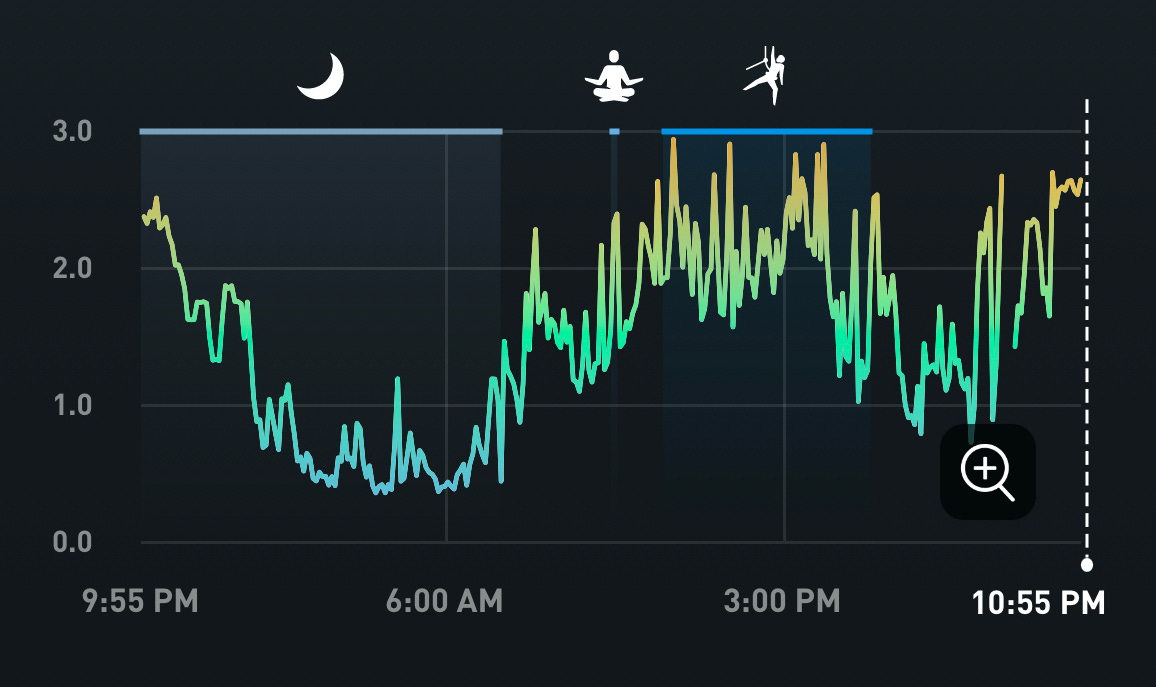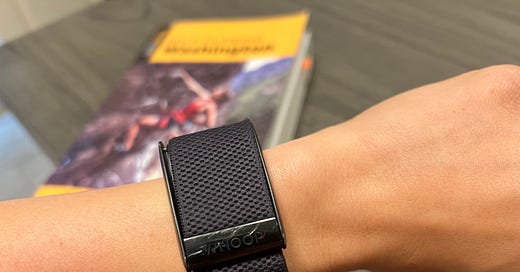Whoop: A One-Month Review
Increase Recovery Rate to Unlock Peak Performance. This fancy fitness tracking is not for everyone.
Since I started climbing more regularly, I have observed that to have a high-performance climbing day, we must prioritize a great rest day. Balance is where optimal gains lie.
I have been using a free trial membership for a fitness tracker, Whoop. Unlike other devices such as the Apple Watch or Fitbit, Whoop is much more opinionated. It has a secret sauce to derive your recovery rate and provide recommendations for the appropriate intensity of your exercise.
One month later, I decide to return it. Here is why:
Favorite Feature: Stress Monitoring
It's important to note Whoop's definition of stress:
Stress is the body’s natural response to a physical or mental challenge. It’s a measure of how alert or activate your body is at any given time.
Outside of chronic stress, stress isn’t inherently good or bad - you just want to have the right amount of it depends on your goals or activity.
You want your stress level to be low in bed and high during intense exercise. Here are my stats on an outdoor climbing day.

Observing the graph, the high level of stress during the climbing sessions reflects exactly the crux move of each climb, which is really cool to see. Additionally, we could also observe relatively high stress during bedtime, meditation, and social media scroll. This stats prompted me to investigate my routine more closely.
Impact
After further observations, I noticed that counting breaths during meditation forced me to hold my breath and tense my body, resulting in higher stress. This was a quite surprising discovery! Different methods of meditation, such as body scans and progressive relaxation, actually lowered my stress level. When I applied these new techniques before bedtime, I found that the stress level reduced significantly during the night
I also investigated my time spent on social media and found that most of the peaks were during content creation. Editing videos, writing captions, and posting can be stressful when I am worried about how the post will perform. Reminding myself that the posts are for me and not for validation eased out some stress. Being more body-aware and reducing the amount of time spent also helped.
High Potential Feature: Activity Insight
Whoop analyzes the combination of your heart rate data and your logging journal to find out the impact of specific activities on your recovery rate. For example, air travel, alcohol, late meals, and sickness have a negative impact on most people's recovery. Although some of the stats are obvious, the personalized version of this data is quite powerful and actionable.
My personal data shows that traveling and, surprisingly, parenting have positive impact on my recovery. This is an interesting stats because despite more stress during babysitting, I tend to exercise less and sleep more on those days.
On the contrary, spending too much time exercising or in a high-stress zone negatively impacts my recovery rate. Another proof point for finding the right balance for optimal performance.
Impact
These insights prompted us to change some routines. My partner and I started limiting our alcohol intake, wearing an eye mask, and using sauna room more consistently in the past month. We determined to turn off the lights by 9:30 pm and wake up at 6 am regularly for higher sleep performance.
Could Be Improved: Strength Trainer
Whoop employs its own formula, a combination of heart rate variability (HRV), resting heart rate (RHR), respiratory rate, and sleep performance, to calculate our recovery rate of the day. Personally, this number does not always reflect how I actually feel when I wake up.
Assumed that the data is likely more accurate than my own feeling, I pushed hard on the high-recovery days and used low recovery to signal a rest day. Despite following the recommendations, I didn't necessarily perform well on the high-recovery days.
Limitation on tracking muscle strain
Recovery rate is heavily tied to heart rate statistics. Cardio-based exercises like running or hiking directly impact heart rate and, hence, affect next-day recovery rate. On the contrary, strength-based training like weightlifting or climbing is much less measurable through heart rate. Hence, I often has a day with high recovery despite muscle soreness.
Whoop is aware of their limitation to track muscle strain on recovery. Their solution is to use Strength Trainer, a pre-program workout, which claims to capture additional strain and recovery through body movement. The problem is that the workout is only limited to weight lifting and unclear how to use it for other strength-based exercises.
Bottom Line
Data is just noise without insight and actions. Luckily, we were able to gain interesting learnings and take actions to shape our new routines based on Whoop's recommendations. This is because we have a very flexible schedule that focuses on our climbing training.
When we talked to friends who worked full-time with kids, they were not able to adjust their schedule based on Whoop’s recommendations. They could only leverage the stress monitor for day-to-day stress tracking.
My take is that Whoop could be a highly leveraged device for full-time cardio-based athletes. It is too expensive for someone who isn’t trying to train for peak performance or not able to take actions based on recommendation. You can get all the same heart rate or sleep statistics on other devices without a monthly subscription.
One thing to think about this week
Are you finding a balance between training and rest for any activity you're attempting? How do you measure it?
We will be spending the weekend doing Single Pitch Instructor course in Boulder! I will be writing about the course in the next newsletter on Tuesday September 12th! 🧗





